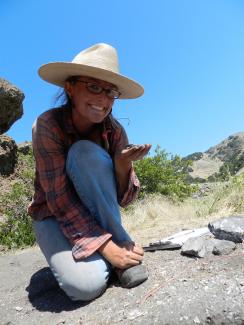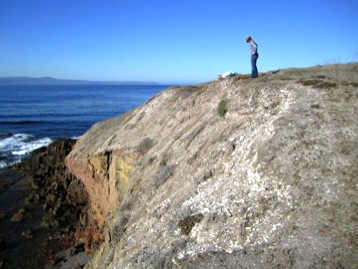
- California Archaeology, Island and Coastal Archaeology
- Paleoethnobotany, Macrobotanical Analysis
- Historical Cultural Ecology
Education:
2015 Ph.D. in Anthropology, University of California, Santa Barbara
2007 M.A. in Anthropology, University of California, Santa Barbara.
2004 B.A. in History, with a Minor in Anthropology, California Polytechnic State University, San Luis Obispo.
Research:
I am an archaeologist working primarily in coastal California, whose research is focused on reconstructing prehistoric subsistence practices. I have worked in various areas throughout California, although my dissertation research is focused on subsistence and settlement on the northern Channel Islands. Paleoethnobotanical analyses are critical in understanding how the Island Chumash, who had a strong maritime focus, used plant foods available locally on the islands to complement abundant marine food resources such as fish, sea mammals and shellfish. Carbonized Blue Dick corms (Dichelostemma capitatum) identified archaeologically in great abundance and in multiple strata representing a nearly 6,000 year sequence at the Diablo Valdez site (SCRI-619/620) on Santa Cruz Island, indicate that island plant foods were used consistently, and were likely very important, through time. My research has brought into question the prevailing assumption that island plant foods were marginal compared with the mainland, indicating instead that the islands would have been optimal particularly for geophytes, a highly ranked plant food source. This idea has profound implications for subsistence and settlement on the islands, from the initial occupation of Santarosae (the larger, single island comprised of the four current northern Channel Islands before sea level rise) around 13,000 years ago, to the development of socio-political complexity and increase in regional trade seen later in time.
Projects:
Rapid Archaeological Assessment on Santa Cruz Island: GIS Modeling, Sea Level Rise and Archaeological Survey
Collaborators: Jon Erlandson, Torben Rick, Kristina Gill, Todd Braje, and Leslie Reeder-Myers
The rapid archaeological assessment of Santa Cruz Island project is part of a collaborative research agreement between The Nature Conservancy, the Smithsonian Institution, and the University of Oregon, focused on documenting archaeological sites that are imminently threatened by accelerating sea level rise. Kristina Gill (UC Santa Barbara) is a collaborator on the project, conducting fieldwork and paleoethnobotanical analyses. Sea level rise is one of the major destructive forces to coastal archaeological sites around the world, including the Channel Islands. As sea level rises, coastal archaeological sites are destroyed or damaged by marine erosion, causing permanent loss of non-renewable cultural resources. Coastal archaeological sites are important repositories of human environmental interactions, with materials that are valuable for understanding ancient and modern biological and botanical resources and conservation (see Erlandson and Rick 2010; Rick et al. 2014). Consequently, the erosion of archaeological sites is a loss of both cultural and ecological knowledge. With global sea level rise accelerating, the potential magnitude of such losses is increasing dramatically. Building on long standing research on San Miguel, Santa Rosa, and Anacapa islands, the Smithsonian Institution and University of Oregon combined forces to conduct archaeological research at key areas on the Nature Conservancy portion of Santa Cruz Island. Our project seeks to evaluate the utility of GIS predictive models for documenting potential threats of sea level rise to Santa Cruz Island archaeological sites by conducting archaeol ogical survey, site assessment, and radiocarbon dating. In some cases, small bulk soils samples are collected for further analysis, including paleoethnobotany, which provides historical ecological information about the island’s terrestrial plant resources prior to historical overgrazing. Extensive radiocarbon dating has so far produced an essentially continuous sequence of 9000 years of human occupation along Santa Cruz Island’s coast.
ogical survey, site assessment, and radiocarbon dating. In some cases, small bulk soils samples are collected for further analysis, including paleoethnobotany, which provides historical ecological information about the island’s terrestrial plant resources prior to historical overgrazing. Extensive radiocarbon dating has so far produced an essentially continuous sequence of 9000 years of human occupation along Santa Cruz Island’s coast.
Photo caption: J. Erlandson and K.Gill inspecting coastal erosion at a large village site (SCRI-192) on Santa Cruz Island. Photo by T. Rick.
Enculturating Environments: The Archaeology of Interior South-Central California
This long-term research project led by Drs. David W. Robinson (University of Central Lancashire) and Fraser Sturt (University of Southampton) focuses on the human enculturation of the landscape and environment within the context of rock art on the Wind Wolves Preserve in the San Emigdio Hills, along the southwestern edge of the southern San Joaquin Valley. The region has generally been under-researched archaeologically, yet is known ethnohistorically to be an interface between several different indigenous linguistic groups, including the interior Chumash and Yokuts. In addition, the Emigdio Hills area contains some of the most spectacular and well-known rock art in southern California, and arguably the world. The project directors are specifically interested in understanding the social contexts within which rock art was made and viewed, and how this changed during the proto-Historic Period. Kristina Gill conducted paleoethnobotanical analysis at four sites, including Pinwheel Cave (KER-5836), Pinwheel BRM (KER-5837), Three Springs (KER-3388) and Pond (KER-1635). Archaeological work at these multi-component sites associated with rock art are shedding new light on the prehistoric use of this area, effects of increased culture contact, including contact with Europeans, and the enculturation of the landscape and environment through rock art.
Funding for this project provided by the University of Central Lancashire and the University of Southampton.
The Paleocoastal Research Project: An Interdisciplinary Search for Maritime Connections in the Peopling of the Americas
The Paleocoastal Research Project is led by Drs. Jon M. Erlandson (University of Oregon), Torben C. Rick (Smithsonian Institution), and Todd J. Braje (San Diego State University). Focused on California’s Northern Channel Islandsand surrounding areas, Project team members are actively investigating early maritime adaptations along the Pacific Coast of North America, as well as broader connections between Paleocoastal peoples and their neighbors in western North America, South America, and the larger Pacific Rim region. Project members have identified more than 50 Channel Island sites dated between about 12,200 and 8000 years ago, defined distinctive Paleocoastal technologies, and contributed to a deeper understanding of how the Channel Islands changed through time. Project members have also contributed to the development of the coastal migration theory and kelp highway hypothesis, which has largely replaced the traditional ‘ice-free corridor’ and ‘Clovis First’ models that proposed that the Americas were settled by terrestrial hunting peoples ~13,000 years ago. A growing body of archaeological, genetic, and geological data now suggest that the First Americans followed the coastlines of northeast Asia and southern Beringia into the New World, migrating down the Pacific Coast as many as 15-16,000 years ago. Kristina Gill serves as a team member, participating in fieldwork and conducting paleoethnobotanical analysis for the project.
Funding for this research has been provided by the Betty Soreng Family Trust, Don Dana Family Foundation, Foundation for Exploration and Research into Cultural Origins, National Center for Ecological Analysis and Synthesis, National Geographic Society, National Park Service, National Science Foundation, Oregon Sea Grant, San Diego State University, Smithsonian Institution, University of Oregon, Watts Family Foundation, and the Western National Parks Association.
Prehistoric Plant Use Among Complex Maritime Hunter-Gatherer-Fishers, Santa Cruz Island, California
For her dissertation research project, Kristina Gill is analyzing carbonized plant remains from prehistoric habitation sites on Santa Cruz Island, off the coast of southern California. Her goal is to examine the role of plant food resources among prehistoric maritime hunter-gatherer-fishers, and how the importance of plants changed through time in response to environmental stress and increased trade with mainland populations. The extent to which locally available plant resources were used through time is important for understanding changes in subsistence, settlement, regional exchange, and socio-political complexity. Excavations at the Diablo Valdez site (SCRI-619/620), occupied from 5700 years ago until after European contact (AD 1782), yielded a large number of carbonized Blue Dick (Dichelostemma capitatum) corms in multiple strata, indicating the importance of this highly-ranked plant food through time. This research project examines both floral and faunal food resource use in terms of foraging theory and diet breadth models, in an island context where marine resources are particularly abundant. Cross-cultural comparison, specifically with regard to the relative importance of plants, among various maritime hunter-gatherer-fisher societies will provide new insights into how foraging decisions were made.
Funding for this research has been provided by the National Science Foundation, Mildred E. Mathias Research Grant, Peter Paige Memorial Grant, and UC Santa Barbara, Department of Anthropology.
Publications:
2014 Seasons of Change: Using Seasonal Morphological Changes in Brodiaea Corms to Determine Season of Harvest from Archaeobotanical Remains. American Antiquity 79(4)
2014 The Island Chumash and Exchange in the Santa Barbara Channel Region. American Antiquity 79(3):570-572 (Kristina M. Gill and Jon M. Erlandson)
2014. Ecology of the Kelp Highway: Did Marine Resources Facilitate Human Dispersal from Northeast Asia to the Americas? Journal of Island and Coastal Archaeology (in review) (Jon M. Erlandson, Todd J. Braje, and Kristina M. Gill)
2014. Three Late Paleocoastal Shell Middens on Santa Cruz Island, California. PaleoAmerica (in review) (Jon M. Erlandson, Kristina M. Gill, Torben C. Rick, and Leslie Reeder-Myers)